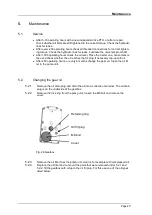
Operation
Page 19
Attention!
There is an increased risk of accident due to the rotating PTO shaft.
Do not enter the work area of the PTO shaft when it is rotating.
For your own safety do not wear any loose clothing, belts, or any other
loose items. Switch off the implement. Wait until all machine parts have
come to a standstill before converting or servicing the implement.
4.3.1.
Detach the safety chain on both sides.
4.3.2.
Press the locking pin on the outer fork and keep it depressed.
4.3.3.
Pull the outer fork down from the profile stub of the PTO shaft on the tractor.
4.3.4.
Release the locking pin.
4.3.5.
Repeat steps 2 to 4 to detach the universal joint shaft on the implement.
4.4.
Switching the independent live PTO on and off
4.4.1.
Switch-on the independent live PTO - switch on the switch for the front PTO shaft.
Switch on the independent live PTO at approx. 1000 rpm, and do not increase the
rpms of the tractor engine when switching on the independent live PTO. Do not
switch on the independent live PTO at a speed greater than 1200 rpm.
4.4.2.
Switch-off the independent live PTO - switch off the switch for the front PTO shaft.
4.4.3.
Never attempt to loosen a seized front implement by switching the independent
live PTO on and off.
4.5.
Run-up time of the front PTO shaft system
The run-up time of the front PTO shaft system (only necessary if extremely light or ex-
tremely heavy implements will be driven) can be adjusted on the switch-on electronics. If
the front PTO shaft system will power an extremely light implement, the run-up time must
be long (rotate the set screw counterclockwise) so that the system switches on less
abruptly. In the case of powering extremely heavy implements the run-up time should be
adjusted as short as possible (turn the set screw clockwise) to reduce wear on the cou-
pling.
Fig. 27 Switch-on electronics
Set screw





































